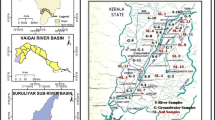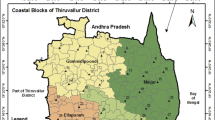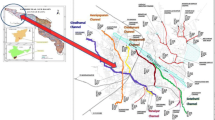Abstract
Assessment of groundwater and surface water quality along a river is important as it directly affects the agricultural, industrial activities and population. The objective of the study is to assess the quality of the Cauvery river water and adjacent groundwater for drinking and irrigational purposes and to identify the infuence of geogenic and anthropogenic sources. Groundwater and surface water samples were collected along the course of the river at approximate intervals of 25 km. The samples were analysed for electrical conductivity, pH, sodium, calcium, magnesium, potassium, bicarbonate, chloride and sulphate. Sodium was identified as the dominant cation and bicarbonate was the dominant anion for both river water and groundwater. These values were compared with limits recommended by the Bureau of Indian Standards for drinking purposes. The total dissolved solids were found to exceed the permissible limits for drinking water in most of the groundwater samples, and it was below the permissible limits in river water samples. Most of the river water samples were found to be suitable as per the drinking water quality standards, but most of the groundwater samples were unsuitable based on the concentration of major ions. Irrigation water quality was also assessed based on magnesium hazard, residual sodium carbonate, sodium percentage, sodium adsorption ratio, permeability index and salinity hazard. Most of the river water samples collected were suitable for irrigation, whereas most of the groundwater samples collected were doubtful for irrigation based on residual sodium carbonate and sodium percentage. Drinking water and irrigation water quality indices were also computed to assess the characteristics of water. Groundwater quality in locations nearer to the confluence of tributaries and industrial areas was of poor quality, while both river water and groundwater near the coast were poor, both for drinking and irrigation purposes. Comparison of the dissolved load with other rivers of the world was also made, which reveals that the Cauvery River yields comparatively higher dissolved load per area than most of the rivers. The chemical load in the river is due to natural and anthropogenic sources. Therefore, it is necessary to enforce the existing norms for the discharge of treated effluents by industries and townships along the river so as to reduce the chemicals contributed by anthropogenic sources.









Similar content being viewed by others
References
Afroz R, Banna H, Masud MM, Akhtar R, Yahaya SR (2016) Household’s perception of water pollution and its economic impact on human health in Malaysia. Desalination and Water Treatment 57(1):115–123
APHA (1998) Standard methods for the examination of water and wastewater, 20th edn. American Public Health Association/American Water Works Association/Water Environment Federation, Washington, DC
Ayers RS, Westcot DW (1985) Water quality for agriculture, vol 29. Food and Agriculture Organization of the United Nations, Rome
Basu S, Lokesh KS (2012) Trend of temporal variation of Cauvery river water quality at KR Nagar in Karnataka. Int J Eng Sci Technol 4(8):3693–3699
Bhargava DS (1985) Water quality variations and control technology of Yamuna river. Environ Pollut A 37(4):355–376
Bhutiani R, Khanna DR, Kulkarni DB, Ruhela M (2016) Assessment of Ganga river ecosystem at Haridwar, Uttarakhand, India with reference to water quality indices. Appl Water Sci 6(2):107–113
BIS (1982) Indian standard tolerance limits for Inland surface water subject to pollution, IS 2296:1982. Bureau of Indian Standards, New Delhi
BIS (2012) Indian standard drinking water specification, second revision IS 10500:2012. Bureau of Indian Standards, Drinking Water Sectional Committee, FAD25, New Delhi
Brown RM, McCleiland NJ, Deiniger RA and O’Connor MFA (1972) Water quality index—crossing the physical barrier. In: Jenkis SH (ed) Proceedings in international conference on water pollution research. Jerusalem, pp 787–797
Brown P, El Gohary F, Tawfic MA, Hamdy EI, Abdel-Gawad S (2003) Nile river water quality management study. Egypt Water Policy Reform, United States Agency for International Development, Egypt
CPCB (Central Pollution Control Board) (2008) Status of water quality in India—2007. http://www.cpcb.nic.in/upload/NewItems/NewItem_129_NWMP-2007.pdf. Accessed 21 Dec 2016
CPCB (Central Pollution Control Board) (2014) Status of water quality in India—2007. https://data.gov.in/catalog/status-water-quality-india-2012. Accessed 21 Dec 2016
CWC (Central Water Commission) (2016) Integrated hydrologic data book, New Delhi. http://www.cwc.nic.in/main/downloads/IHD2015_final.pdf. Accessed 21 Dec 2016
Dahunsi SO, Owamah HI, Ayandiran TA, Oranusi SU (2014) Drinking water quality and public health of selected towns in South Western Nigeria. Water Qual Expo Health 6(3):143–153
Domenico PA, Schwartz FW (1990) Physical and chemical hydrogeology. Wiley, New York, pp 410–420
Doneen LD (1964) Water quality for agriculture. Department of Irrigation, University of California, Davis
Eaton EM (1950) Significance of carbonates in irrigation waters. Soil Sci 69:123–133
Freeze RA, Cherry JA (1979) Groundwater. Englewood Cliffs, New Jersey, p 604
Gaillardet J, Dupre B, Louvat P, Allegre CJ (1999) Global silicate weathering and CO2 consumption rates deduced from the chemistry of large rivers. Chem Geol 159(1):3–30
Garbarino JR, Antweiler RC, Brinton TI, Roth DA, Taylor HE (1995) Concentration and transport data for selected dissolved inorganic constituents and dissolved organic carbon in water collected from the Mississippi River and some of its tributaries, July 1991–May 1992. US Geol Surv Open File Rep 149:95–149
Goher ME, Hassan AM, Abdel-Moniem IA, Fahmy AH, El-sayed SM (2014) Evaluation of surface water quality and heavy metal indices of Ismailia Canal, Nile River, Egypt. Egypt J Aquat Res 40(3):225–233
Grosbois C, Négrel P, Grimaud D, Fouillac C (2001) An overview of dissolved and suspended matter fluxes in the Loire river basin: natural and anthropogenic inputs. Aquat Geochem 7(2):81–105
Hart FG (1999) World delta database, Cauvery. http://www.geol.lsu.edu/WDD/ASIAN/Cauvery/cauvery.htm. Accessed 21 Dec 2016
Huang X, Sillanpää M, Gjessing ET, Peräniemi S, Vogt RD (2011) Water quality in the southern Tibetan Plateau: chemical evaluation of the Yarlung Tsangpo (Brahmaputra). River Res Appl 27(1):113–121
India Wris Wiki (2015) Cauvery. http://www.india-wris.nrsc.gov.in/wrpinfo/index.php?title=Cauvery. Accessed on 21 Sept
Jayananda M, Moyen JF, Martin H, Peucat JJ, Auvray B, Mahabaleswar B (2000) Late Archaean (2550 2520 Ma) juvenile magmatism in the Eastern Dharwar craton, southern India: constraints from geochronology, Nd Sr isotopes, and whole rock geochemistry. Precambrian Res 99:225–254
John MM, Balakrishnan S, Bhadra BK (2005) Contrasting metamorphism across Cauvery Shear Zone, south India. J Earth Syst Sci 114(2):1–16
Kalpana L, Elango L (2013) Assessment of groundwater quality for drinking and irrigation purposes in Pambar river sub-basin, Tamil Nadu. Indian J Environ Prot 33(1):1–8
Kelly WP (1957) Adsorbed sodium cation exchange capacity and percentage sodium sorption in alkali soils. Science 84:473–477
Lloyd JW, Heathcote JA (1985) Natural inorganic hydrochemistry in relation to groundwater. Clarendon Press, Oxford
Meybeck M (1983) Atmospheric inputs and river transport of dissolved substances. Dissolved Loads Rivers Surf Water Quant/Qual Relationsh 141:173–192
Meybeck M, Ragu A (2012) GEMS-GLORI world river discharge database. Laboratoire De Géologie Appliquée, Université Pierre et Marie Curie, Paris
Milliman J (2001) River inputs. In: Steele JH (ed) Encyclopedia of ocean sciences. Academic Press, London, pp 2419–2427
Mohsin M, Safdar S, Asghar F, Jamal F (2013) Assessment of drinking water quality and its impact on residents health in Bahawalpur city. Int J Humanit Soc Sci 3(15):114–128
Moosdorf N, Hartmann J, Lauerwald R, Hagedorn B, Kempe S (2011) Atmospheric CO2 consumption by chemical weathering in North America. Geochim Cosmochim Acta 75(24):7829–7854
Mukherjee D, Chattopadhyay M, Lahiri SC (1993) Water quality of the River Ganga (The Ganges) and some of its physico-chemical properties. Environmentalist 13(3):199–210
Naqvi SM, Divakara Rao V, Satyanarayana K, Hussain SM (1974) Geochemistry of post-Dharwar basic dykes and the Precambrian crustal evolution of Peninsular India. Geol Mag 111:229–236
Pattanaik JK, Balakrishnan S, Bhutani R, Singh P (2013) Estimation of weathering rates and CO2 drawdown based on solute load: significance of granulites and gneisses dominated weathering in the Kaveri River basin, southern India. Geochim Cosmochim Acta 121:611–636
Pichamuthu CS (1976) Some problems pertaining to the Peninsular Gneiss Complex. J Geol Soc India 17:1–16
Pichamuthu CS (1978) Archaean geology investigations in southern India. Geol Soc India 19(10):431–439
Piper AM (1944) A graphical procedure in the geochemical interpretation of water analysis. Trans Am Geophys Union 25:914–928
Porcella DB, Sorensen DL (1980) Characteristics of nonpoint source urban runoff and its effects on stream ecosystems. Corvallis Environmental Research Laboratory, Office of Research and Development, US Environmental Protection Agency, United States of America
Radhakrishna BP (1956) The closepet granite of Mysore State, India. Mysore Geologists’ Association Special Publication, Bangalore, pp 1–110
Rao KL (1975) India’s water wealth. Orient Longman, New Delhi
Rasool A, Xiao T, Farooqi A, Shafeeque M, Liu Y, Kamran MA, Katsoyiannis IA, Eqani SAMAS (2017) Quality of tube well water intended for irrigation and human consumption with special emphasis on arsenic contamination in the area of Punjab, Pakistan. Environ Geochem Health 39(4):847–863
Reynolds SE (1972) Water quality problem on the Colorado River. Nat Resour J 12:480
Richards LA (1954) Diagnosis and improvement of saline and Alkali soils. USDA Handbook, Washington, DC
Sawyer CN, McCarty PL (1978) Chemistry of environmental engineering. Series in water resources and environmental engineering, 3rd edn. McGraw–Hill, New York
Shiklomanov IA (1998) World water resources. A new appraisal and assessment for the 21st century. UNESCO, Paris
Shio T, Maddocks A, Carson C, Loizeaux E (2015) 3 Maps explain India’s growing water risks. http://www.wri.org/blog/2015/02/3-maps-explain-india%E2%80%99s-growing-water-risks. Accessed on 5 Oct
Solaraj G, Dhanakumar S, Murthy KR, Mohanraj R (2010) Water quality in select regions of Cauvery Delta River basin, southern India, with emphasis on monsoonal variation. Environ Monit Assess 166(1–4):435–444
Subramanian KS, Selvan TA (2001) Geology of Tamil Nadu and Pondicherry, 1st edn. Geological Society of India, Bangalore, p 192
Sundaram R, Rao PS (1981) Lithostratigraphy of Cretaceous and Palaeocene rocks of Tiruchirapalli District, Tamil Nadu, South India. GSI Rec 115(5):9–23
Suresh M, Gurugnanam B, Vasudevan S, Dharanirajan K, Raj NJ (2010) Drinking and irrigational feasibility of groundwater, GIS spatial mapping in upper Thirumanimuthar sub-basin, Cauvery river, Tamil Nadu. J Geol Soc India 75(3):518–526
Susheela FS, Srikantaswamy FS, Shiva Kumar FD, Gowda FA, Jagadish FK (2014) Study of Cauvery river water pollution and its impact on socio-economic status around KRS Dam, Karnataka, India. J Earth Sci Geotech Eng 4(2):91–109
Szabolcs I, Darab C (1964). The influence of irrigation water of high sodium carbonate content of soils. Proceedings of 8th ISSS Trans, 2:802–812
Todd DK (1959) Ground water hydrology, 2nd edn. Wiley, New York
Vetrimurugan E, Elango L, Rajmohan N (2013) Sources of contaminants and groundwater quality in the coastal part of a river delta. Int J Environ Sci Technol 10:473–486
WBCSD (2006) Business in the world of water: WBCSD water scenarios to 2025. World Business Council for Sustainable Development. http://www.wbcsd.org/Clusters/Water/Resources/Business-in-the-World-of-Water-WBCSD-water-scenarios-to-2025 Accessed 17 May
WHO (1993) Guidelines for drinking water quality. World Health Organization, 2nd edn. Recommendations, WHO, Geneva
WHO (2003a) Sodium in drinking water, background documents for development of WHO guidelines for drinking water quality. World Health Organisation. http://www.who.int/water_sanitation_health/dwq/chemicals/sodium.pdf. Accessed 16 Oct
WHO (2003b) Chloride in drinking water, Background documents for development of WHO guidelines for drinking water quality. World Health Organisation. http://www.who.int/water_sanitation_health/dwq/chloride.pdf. Accessed 16 Oct
WHO (2003c) Total dissolved solids in drinking water, Background documents for development of WHO guidelines for drinking water quality. World Health Organisation. http://www.who.int/water_sanitation_health/dwq/chemicals/tds.pdf. Accessed 18 May
WHO (2007) pH in drinking water, Revised background documents for development of WHO guidelines for drinking water quality. World Health Organisation. http://www.who.int/water_sanitation_health/dwq/chemicals/ph_revised_2007_clean_version.pdf. Accessed 16 Oct
Wilcox LV (1955) Classification and use of irrigation waters. USDA, Washington, DC
Zhang J, Huang WW, Letolle R, Jusserand C (1995) Major element chemistry of the Huanghe (Yellow River), China-weathering processes and chemical fluxes. J Hydrol 168(1):173–203
Zheng Q, Ma T, Wang Y, Yan Y, Liu L (2017) Hydrochemical characteristics and quality assessment of shallow groundwater in Xincai River Basin, Northern China. Procedia Earth Planet Sci 17:368–371
Zhu B (2016) Natural water quality and its suitability for drinking and irrigation purposes in the Jungar Basin, Central Asia. J Civil Environ Eng 6:232
Acknowledgements
The authors thank the Indian Space Research Organisation and National Remote Sensing Centre [Grant No. ISRO/IGBP/NCP/NRSC/Project funds/10-2012(2)] for financial support. Thanks are also due to students namely Phrangbor Syiem, Gopalakrishnan N. and Dhanamadavan S. for their assistance in sample collection and analyses during the initial stages of this work.
Author information
Authors and Affiliations
Corresponding author
Rights and permissions
About this article
Cite this article
RamyaPriya, R., Elango, L. Evaluation of geogenic and anthropogenic impacts on spatio-temporal variation in quality of surface water and groundwater along Cauvery River, India. Environ Earth Sci 77, 2 (2018). https://doi.org/10.1007/s12665-017-7176-6
Received:
Accepted:
Published:
DOI: https://doi.org/10.1007/s12665-017-7176-6




